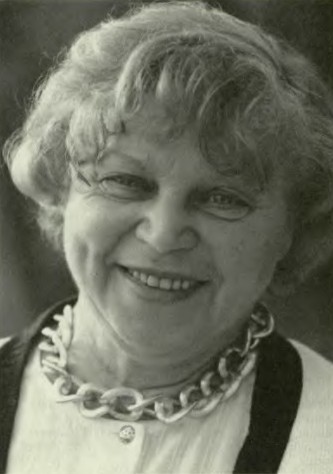Writer, promoter of Silesian folk culture in Germany, and advocate for international understanding.

Hanna-Barbara Strehblow was born in Jelenia Góra (Hirschberg) to Franz and Katarzyna Rauthe. Her father was originally from Harrachov (Harrachsdorf), where his parents, Hanna Barbara’s grandparents, owned a glass-cutting workshop and a beer hall called “Teufelsberger Bierhalle.” In the 1920s, Barbara’s father gained recognition beyond the area of Stará Erlebachova Bouda and Špindlerův Mlýn (Spindlermühle; Špindlerův Mlýn) as a ski instructor and performer of musical pieces on the zither. The writer’s mother, Katarzyna Rauthe (née Jannuschka), came from Będzin in Upper Silesia and suffered from mental illness. After two suicide attempts and a stay in a care facility for the mentally ill in Płakowice (Plagwitz) near Lwówek, she died as a result of euthanasia imposed by the Nazis [1].
The future writer’s father, Franz Rauthe, left the family, moving to the Czech Republic in 1932. The five-year-old girl and her brother Gerhard were cared for by the youngest sister of their grandmother, Marta Dressler. Marta lived with her mother, Barbara Feist (née Erlebach, 1847–1936), who came from the family that owned the iconic Karkonosze mountain lodge, Alte Erlebachbaude, located on the Karkonosze Pass (Spindlerpass). The strong personality of her great-grandmother, along with the deeply cherished Silesian traditions she upheld, had a profound impact on the young girl. This influence led, many years later, to her adopting the pen name Erle Bach, referencing her ancestors’ surname and their historic mountain inn.
The future writer learned the famous embroidery stitch of Jelenia Góra and the unique tulle embroidery technique of Jelenia Góra (Hirschberger Nadeltüll) from her great-grandmother. Hanna Barbara grew up in very modest circumstances, which meant her education ended at primary school before the war. However, the skills she gained from her great-grandmother, her fondness for the folk traditions of the Karkonosze region, and her active participation in local groups promoting traditional folk costumes often led young Hanna Barbara to be invited, along with other children, as a “Trachtenputzel,” a girl dressed in folk attire, to present flowers during ceremonial events. Through these opportunities, she met many famous figures, including Gerhart Hauptmann, Hanna Reitsch, and Countess Mia von Schaffgotsch.
At the end of the war, Hanna Barbara Rauthe was in a village near the mountains, where she experienced traumatic events due to the significant threat posed by Soviet soldiers, who were looting property and assaulting local women. These dramatic experiences later became the basis for her most famous and perhaps best-crafted book, the collection of short stories “Mother with Bare Feet” (Mutter mit den bloßen Füßen). In this book, the author described real events, including a vivid portrayal of a Polish settler who took in a German girl to protect her from assaults or deportation to forced labor in Russia.
She didn’t speak German, and I didn’t speak Polish. She hid me among her children and took on the risk of being punished for it by her own militia or soldiers
[2].
After being expelled from her home, the future writer ended up in the Soviet occupation zone in Thuringia, where she had to work in forestry. Even there, she received help from a Polish man, with whose assistance she managed to escape to the West. It was likely the help she received from Poles during the most difficult moments of her life that inspired her, in later years, to become a strong advocate for reconciliation and understanding between nations after settling in the Federal Republic of Germany.
On the other side of the Iron Curtain, Hanna Barbara took on various jobs: she worked as a fashion designer, an extra, a domestic worker, and an office employee.
After marrying in 1950 and taking her husband’s surname, Barbara Strehblow settled in southern Baden, in Efringen-Kirchen, a town located at the junction of France, Germany, and Switzerland. There, she devoted herself primarily to raising her four children but did not abandon her dedication to preserving her native dialect and promoting the folk art traditions of Lower Silesia, especially the famous embroidery techniques of Jelenia Góra.
After raising her children, Barbara Strehblow adopted the literary pseudonym Erle Bach, as previously mentioned, and enthusiastically devoted herself to cultural and literary pursuits. It is thanks to her efforts that the famous embroidery and lacework of Jelenia Góra [3] have not fallen into oblivion. The writer not only organized courses on Silesian embroidery but also founded groups dedicated to preserving Silesian folk costumes. In 1982, she even established the Archive of the Silesian Dialect [4] and published a periodical titled “Woas die Stoare pfeifa” (What the Starlings Are Whistling) in the Silesian dialect, which was spoken by approximately seven million people before 1945. Erle Bach was also highly active in Silesian expatriate organizations, consistently promoting the ideas of understanding and reconciliation. Her efforts earned her recognition from figures such as Simon Wiesenthal.
The central literary theme of Erle Bach’s work was the suffering of mothers and their children during the war. However, she did not dwell solely on the horrors of war. Her writings also included excellent studies of her lost homeland, Lower Silesia. Among her contributions is a well-crafted literary monograph on Jelenia Góra, “Das alte Hirschberg zwischen Handel und Poesie” (Old Hirschberg Between Trade and Poetry), which provides today’s residents of Jelenia Góra with valuable insights into the history of their city.
Her tireless activities, which earned her numerous awards—including the Federal Cross of Merit with Ribbon in 1988 for her contributions to international understanding and research on folk culture—were ultimately cut short by severe heart disease. Erle Bach passed away in May 1996.